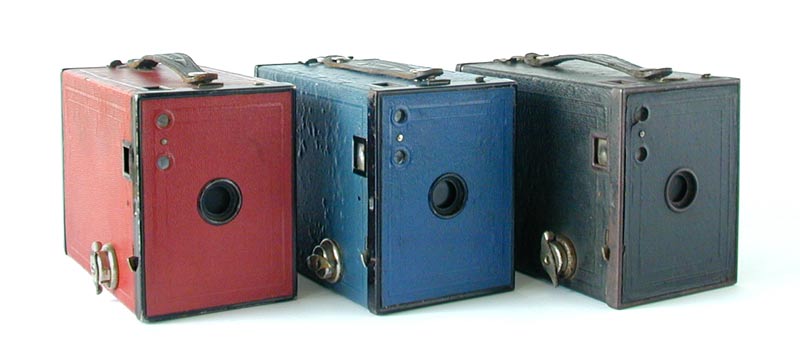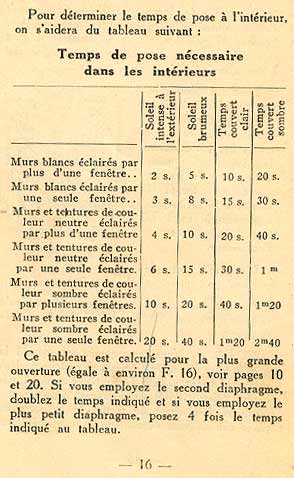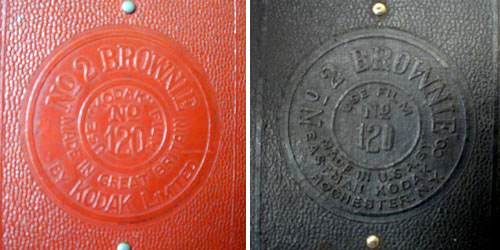
– Brownie Camera Nº 2 | Kodak | 1901/1933 –
Very special camera. The film 120 was introduced in the market for the Brownies! The same film that fits Super Ikontas, Rolleis, Hasselblads and so many other top cameras. The red one is in excellent condition and was a gift from a german friend who received it from his father when he was a child. I have also a black , also a gift from a friend.Recently I found the blue one on Ebay, an here they are, the three graces.
The lens is simply a meniscus with a rotary shutter. You have three options for diaphragm sliding a blade with holes on it. It clicks on the right spot. Speeds are B or something around 1/30
Light meters were a professional item. At that time, most of the week-end photographers were used in reading and interpreting charts like the one below. It was printed with the owners manual for Brownies Nº2. Note that this chart is intended for indoor photography there is nothing below 2 seconds.

This situation, 2 seconds, is the case when walls are white, with full sun outside and at least two windows are open. Then one can take pictures with 2 seconds time using the larger diafragm (f16, f20 and f32 are available). Those tiny apertures are consequence of having a simple meniscus as a lens, there is no correction whatsoever and that limits a lot the useful lens’ diameter. For outdoors, only with sunny days one can use the shutter in position “instantanées”. Otherwise B is a must. Not easy.
The idea of Kodak with these cameras was to make photography affordable to everybody, cost and technically speaking . Together with cameras, they marketed all that was needed to allow amateurs to go from shooting to final printing at home and without a traditional darkroom. Beyond that, what proved to be the very future of photography, Kodak also offered development and printing services by mail order.
Not even electricity was a must to record one’s memories. Kodak marketed also enlargers using daylight. Very simple idea, something like a camera with film in one side and paper on the other.
Another interesting accessory was the Kodak Amateur Flash Outfit that is also featured in the camera manual.
Here you have pages 2 and 3 of owners manual:

The Brownies were so successful that were produced in several countries. The blue and the red were made in Great Britain and the black one in USA. Find more information about Brownies and its interesting print advertising at: The Brownie Camera Page

Despite all its simplicity, this did not prevent the Kodak Brownie Nº2 from being among the most sophisticated cameras in the history of analog photography when, in 1954, Virginia Schau had her photo “Rescue On Pit River Bridge” awarded with the most important award in American photojournalism. Virginia was the first woman to win the Pulitzer Prize for Photography. An amateur, she said that she always took her camera with her, but almost never took pictures with it. On May 3, 1953, she was going fishing with her parents and her husband when they saw the serious accident with a truck that was left hanging from the bridge. The driver and his assistant were on the verge of falling with the entire cabin into the riverbed and needed to be removed from there immediately. While the men provided the rescue, she took her Brownie, in which she had only two pictures left, positioned herself and took the photo just as the truck driver was hoisted onto the bridge. Virginia used sunlight, positioning herself in such a way as to draw attention to exactly what matters and thus obtained a perfect composition.

She entered the photo into a weekly Sacramento Bee contest and won $10 first prize. The photo was subsequently promoted by the Associated Press, and published worldwide. The following year came the Pulitzer.
The interesting thing about this story is to think that it illustrates well the fact that sophisticated cameras are sophisticated precisely because of their ability to adapt to a large number of different situations, combining the subject with the photographer’s intentions. But with a simple camera, it is the subject that needs to be picked in a way that it suits the limitations of the device, as was the case with the image of Virgínia Schau. It is true that in much less situations, with these cameras, the photographer will be able to make his click. But when that happens, wonderful pictures can emerge.
Finally some pictures I took with the red one. Even with modern film, allowing for far faster speeds, a tripod helps a lot.


